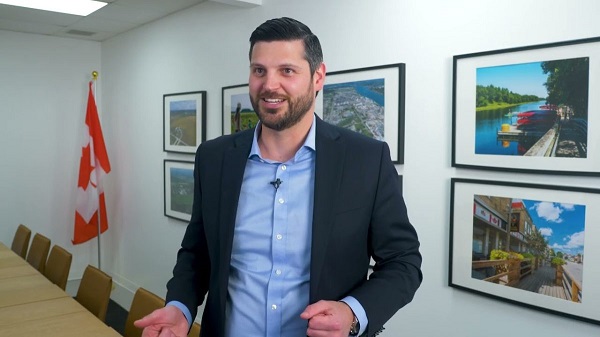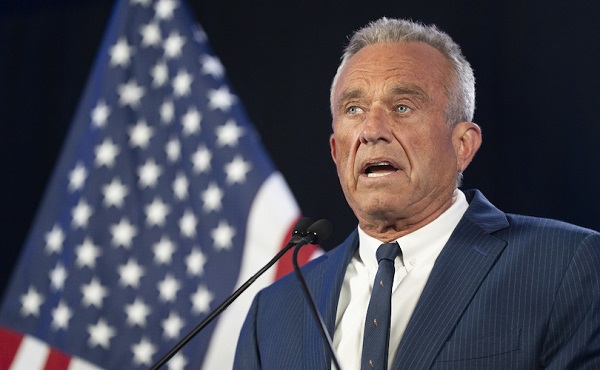Opinion
The Charlie Kirk I Knew
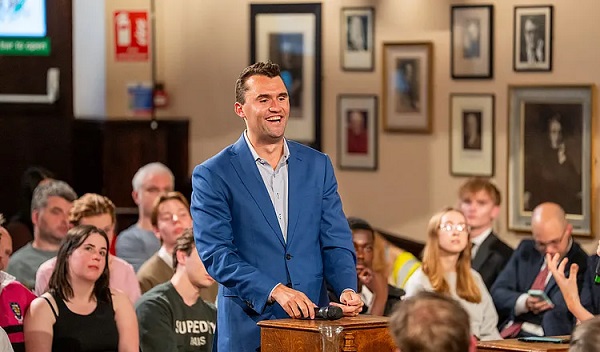
This afternoon, the conservative activist Charlie Kirk was shot and killed while speaking onstage at an event on the campus of Utah Valley University. Kirk, 31, was one of the most influential figures on the contemporary American right. In the below essay, Adam Rubenstein remembers Charlie Kirk, the subject of his 2018 profile, Kid Trump. Here he is on “The Charlie Kirk I Knew.” We’ll be bringing you more on this story in the coming hours and days. —The Editors
In 2019, Charlie Kirk and I were, by complete coincidence, on the same flight, Denver to Chicago. I was going to visit my girlfriend in law school, and he was going home to visit his family in Lemont, a Chicago suburb. He technically still lived with his parents—for the few days a year he wasn’t on the road building his organization, Turning Point USA—and was returning home after a campus visit in Colorado.
While walking down the aisle, Charlie spotted me, seated in a middle row at the back of the plane, and asked the person sitting next to me to switch seats so we could catch up. She obliged, and Charlie sat down next to me. It had been about a year since I’d seen him last. We knew each other because I had written a profile of him in The Weekly Standard, a conservative magazine that was shuttered later that year—a sign of how the conservative movement was transforming in the age of Trump. While we closed our doors, Charlie was raising millions and speaking in front of sold out audiences.
The profile I wrote ended up on the magazine’s cover in August 2018. “Kid Trump” was its headline. To deliver the story, I had spent a week with Charlie, then 24 years old, in Washington, D.C., backstage at a summit he put on for high schoolers in Turning Point USA, on George Washington University’s campus. Five members of the cabinet appeared, as did Mark Cuban, Kellyanne Conway, and Fox News’ Jesse Watters. Students traveled from across the country to attend. Parents came with their children, thrilled by the prospect of seeing Charlie up close.
In the months before publication, I’d meet him periodically at “The Trump,” as he called it—the old post office where President Trump had a hotel.
He was always mobbed. Hotel guests and Trump-adjacent figures would come up to him as we talked. They’d introduce themselves, ask for a selfie, and thank him for his work bringing conservative ideas to America’s youth.
In the profile, I described the movement Charlie was building and what motivated him. He had decided at age 18 against going to college so that he could build Turning Point, to fight back against left-wing excesses—and would tell his audience of adoring, mostly young men and women things that we used to take for granted. Things like “America is the greatest country in the history of the world.” And “The Constitution is the greatest political document ever written.” And “Free market capitalism is the most moral and proven economic system to lift the most people out of poverty into prosperity.”
It is a sign of our times that such messages are now considered radical or fringe.
His talent for public oration, and his infectiously good attitude, propelled him forward. He would say yes to—or try to make happen—any request of him that he could: a student asking him a question about Murray Rothbard (a libertarian economist), an activist asking for a photo (the answer was always yes), a reporter asking about the latest Trump tweet (that was me).
In the week I spent following him around, what I found most striking was how someone at such a young age could command the attention and respect that he did—and in such a short period.
The profile was fair, and by no means a puff piece. And while his flack reached out to me to tell me that I was a Never Trump reptile (or something like that), Charlie texted me a link to my own story and said, “Well done!”
He had a mission. It filled him with meaning. And that, above all, was why he convinced countless young people to listen to him, to change their lives for the better, to stand up for things that used to be called common sense.
That was Charlie. If I had to use a single word to capture him, it would be gracious. We could disagree about anything—and we did—but he would, without fail, engage civilly and explain his point of view. He did not do this, as many do, to make himself feel smart. He did it so he could share the other side of something he cared about. And he cared deeply.
That’s the spirit he took to the hundreds of campuses he visited. Not denunciation. Not shouting down. Never an insult. He sought to debate ideas, and did so in hostile territory. Charlie all but recreated the public town square on these campuses with a tent and an irrepressible smile in an era where many people of his generation can’t look up from their phones.
Today, upon news of Charlie’s murder at the hands of a still-unknown shooter at a university in Utah, Donald Trump said that “No one understood or had the Heart of the Youth in the United States of America better than Charlie.” It was more than that. I saw it. He had a mission. It filled him with meaning. And that, above all, was why he convinced countless young people to listen to him, to change their lives for the better, to stand up for things that used to be called common sense.
Charlie Kirk was not naive. In the video after he is shot, you can see a security team of at least half a dozen bodyguards surround him and spirit him away. Like anyone speaking their mind in public these days, he knew there was a risk.
He had the courage anyway. And today he died under one of those tents where he defended freedom—his, and all of ours.
May his memory be a blessing.
Alberta
Provincial pension plan could boost retirement savings for Albertans

From the Fraser Institute
By Tegan Hill and Joel Emes
In 2026, Albertans may vote on whether or not to leave the Canada Pension Plan (CPP) for a provincial pension plan. While they should weigh the cost and benefits, one thing is clear—Albertans could boost their retirement savings under a provincial pension plan.
Compared to the rest of Canada, Alberta has relatively high rates of employment, higher average incomes and a younger population. Subsequently, Albertans collectively contribute more to the CPP than retirees in the province receive in total CPP payments.
Indeed, from 1981 to 2022 (the latest year of available data), Alberta workers paid 14.4 per cent (annually, on average) of total CPP contributions (typically from their paycheques) while retirees in the province received 10.0 per cent of the payments. That’s a net contribution of $53.6 billion from Albertans over the period.
Alberta’s demographic and income advantages also mean that if the province left the CPP, Albertans could pay lower contribution rates while still receiving the same retirement benefits under a provincial pension plan (in fact, the CPP Act requires that to leave CPP, a province must provide a comparable plan with comparable benefits). This would mean Albertans keep more of their money, which they can use to boost their private retirement savings (e.g. RRSPs or TFSAs).
According to one estimate, Albertans’ contribution rate could fall from 9.9 per cent (the current base CPP rate) to 5.85 per cent under a provincial pension plan. Under this scenario, a typical Albertan earning the median income ($50,000 in 2025) and contributing since age 18, would save $50,023 over their lifetime from paying a lower rate under provincial pension plan. Thanks to the power of compound interest, with a 7.1 per cent (average) nominal rate of return (based on a balanced portfolio of investments), those savings could grow to nearly $190,000 over the same worker’s lifetime.
Pair that amount with what you’d receive from the new provincial pension plan ($265,000) and you’d have $455,000 in retirement income (pre-tax)—nearly 72 per cent more than under the CPP alone.
To be clear, exactly how much you’d save depends on the specific contribution rate for the new provincial pension plan. We use 5.85 per cent in the above scenario, but estimates vary. But even if we assume a higher contribution rate, Albertan’s could still receive more in retirement with the provincial pension plan compared to the current CPP.
Consider the potential with a provincial pension contribution rate of 8.21 per cent. A typical Albertan, contributing since age 18, would generate $330,000 in pre-tax retirement income from the new provincial pension plan plus their private savings, which is nearly one quarter larger than they’d receive from the CPP alone (again, $265,000).
Albertans should consider the full costs and benefits of a provincial pension plan, but it’s clearly Albertans could benefit from higher retirement income due to increased private savings.
Crime
Weapon recovered, manhunt for suspect continues in Kirk assassination investigation

From The Center Square
By
The weapon believed to have been used in the assassination of conservative activist Charlie Kirk has been recovered; however, a manhunt remains ongoing for the suspected shooter.
Authorities held a briefing Thursday morning indicating that investigators recovered a “high-powered bolt action rifle” in a wooded area near the shooting site. Investigators say the “suspect blended in well with a college institution,” believing the suspect to be college aged. They say they have “images of the suspect.”
Investigators also said they made progress overnight in tracking the movements of the suspect before and after the shooting.


“We were able to track the movements of the shooter; starting at 11:52 a.m. the subject arrived on campus, shortly away from campus. We have tracked his movements onto the campus, through the stairwells up to the roof, across the roof to a shooting location. After the shooting, we were able to track his movements as he moved to the other side of the building, jumped off of the building and fled off of the campus and into a neighborhood,” according to the commissioner of the Utah Department of Public Safety, Beau Mason.
The suspected rifle used in the shooting is being sent to an FBI laboratory for analysis. In addition to the recovered weapon, investigators say they collected footwear impressions, a palm print and forearm imprints; however, they didn’t indicate where they were collected.
Ammunition found inside the rifle contained engraved messages of transgender and antifascist ideology, the Wall Street Journal reported.
Kirk was shot in the neck shortly before 12:30 p.m. MDT Wednesday during a campus event at Utah Valley University in Orem, Utah. About 3,000 people were in attendance, and the shooting was captured by multiple spectators and posted to social media.
Two individuals were briefly detained and questioned in relation to the shooting, but were later released, according to FBI Director Kash Patel.
Videos circulating show a shadowy figure, appearing to be dressed in black clothing, who can be seen on a rooftop approximately 200 yards from where Kirk was speaking. The figure can be seen running shortly after the shooting.
The FBI, along with the Utah Department of Public Safety, is leading the investigation.
-

 Crime19 hours ago
Crime19 hours agoCharlie Kirk ASSASSINATED
-
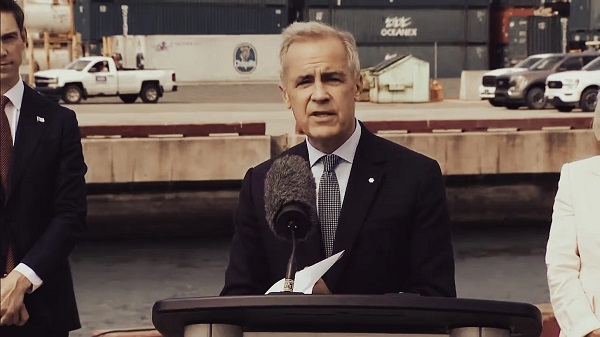
 Business2 days ago
Business2 days agoMark Carney’s Climate Competitiveness Pitch Falls Flat
-
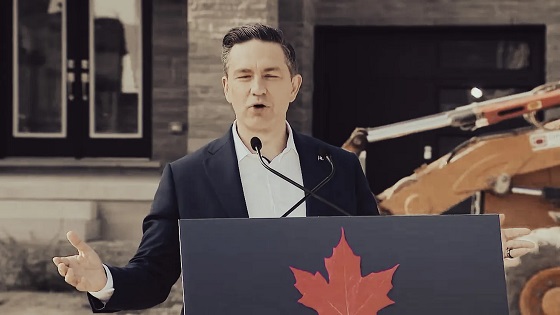
 Business1 day ago
Business1 day agoPoilievre: “Carney More Irresponsible Than Trudeau” as Housing, Jobs, and Energy Failures Mount
-
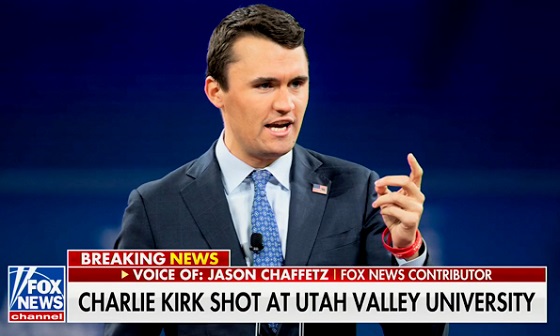
 Crime21 hours ago
Crime21 hours agoConservative speaker and celebrity Charlie Kirk shot during Q & A event at Utah Valley University
-

 Alberta1 day ago
Alberta1 day agoProvince urging post secondary students to apply for loans, grants, scholarships, bursaries and awards
-

 Business2 days ago
Business2 days agoCanada Post is broken beyond repair
-

 International1 day ago
International1 day agoNepal Tried To Censor The Internet. Young People Set Parliament on Fire.
-

 Business2 days ago
Business2 days agoCanada can’t allow so many people to say ‘no’ to energy projects










